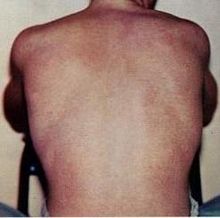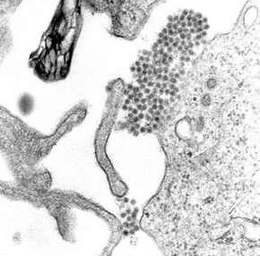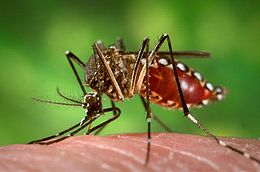Dengue fever
Dengue fever [ˈdɛŋge-], also dandy fever, polka fever, bone-crushing fever, seven-day fever and dengue for short, is a disease caused by infection with the dengue virus. The virus is a 40 to 60 nm enveloped RNA virus with positive polarity from the flavivirus family.
The virus is transmitted by the bite of a mosquito and is common in tropical and subtropical areas. The only known hosts of the virus are primates and various mosquito species. Four different serotypes (subgroups) of the virus exist, which very likely spread independently from non-human primates to humans within the last 2000 years in Asia. Since World War II and subsequent globalization, dengue fever has been on the rise due in part to the spread of its vector and is often referred to as an emerging disease. Dengue fever is the fastest spreading viral mosquito-borne disease, with case numbers increasing thirty-fold from 1960 to 2010.
The disease often manifests itself with non-specific symptoms or those resembling a severe flu; however, internal bleeding may also occur. In a severe course of the disease, a so-called "dengue haemorrhagic fever" (DHF) or dengue shock syndrome (DSS) can occur, both of which can lead to death. The WHO estimates that 50 to 100 million people fall ill each year, 500,000 people suffer a severe course of the disease, and 22,000 people die from dengue fever; most of the fatalities are children. In April 2013, scientists from Oxford and Heidelberg reported in the journal Nature that, according to their studies, around 390 million people are actually infected with dengue fever every year.
For a long time, there was no specific antiviral treatment for the disease. At the end of 2015, the first vaccine "Dengvaxia" was approved by Sanofi, which is supposed to be effective against all four variants of the virus and offer a vaccination protection of 93 %. However, later studies showed that those who had never contracted dengue fever and were then vaccinated with "Dengvaxia" can still become infected later and then develop even more severe symptoms than people who were not vaccinated. In Germany, Austria and Switzerland, there is a notification obligation in the event of suspicion, illness, death, direct and indirect detection of the pathogen or haemorrhagic course of the disease.

The typical rash of dengue fever
Pathogen
→ Main article: Dengue virus
Dengue fever is caused by one of the four serotypes (DENV-1 to DENV-4) of dengue virus, it is a round enveloped virus with a diameter of 40 to 60 nm from the flavivirus family. The viral genome (unlike the DNA used by all living things) consists of ribonucleic acid (RNA). The genome is about 11,000 nucleotides long and is positive-stranded, so it can be read directly by ribosomes and used to form a protein (amino acid chain). The genome comprises only one open reading frame, which codes for a polyprotein (a long amino acid chain, which subsequently still has to be cut into the individual functional proteins).
During infection, viruses attach themselves to the cell surface of a host cell via specific receptors and are taken up by a forming endosomal vesicle. Normally, these vesicles serve to digest substances, but the virus uses them as a means of transport to reach the interior of the cell. Inside the endosome, the acidic pH induces fusion of the endosomal membrane and viral envelope, which allows the viral contents to enter the cytosol. Subsequently, the viral genome is replicated in the rough endoplasmic reticulum (ER) and in so-called vesicle packets, and after maturation in the Golgi apparatus, infectious viral particles are formed. These leave the cell and infect further host cells.
The four different serotypes occur either in demarcated or overlapping endemic zones. Phylogenetic analyses allow the individual serotypes to be subdivided into genotypes. DENV-1 and DENV-2 are divided into five genotypes each, DENV-3 and DENV-4 into four genotypes each. Molecular biology studies revealed that the endemic genotypes split from the forest or jungle (silvatic) genotypes in the last 2000 years. DENV-2 subsequently jumped to humans about 1000 years ago, DENV-4 600 years ago, and DENV-1 200 years ago (all figures ±50%). No silvatic strain of DENV-3 has been isolated so far, and consequently no statement can be made about a possible time when the virus split off.

Dengue virus under the microscope
Transmission
The most important vectors of dengue fever viruses are the females of the yellow fever mosquito (Aedes aegypti, also known as the Egyptian tiger mosquito or dengue mosquito, synonym Stegomyia aegypti) and the Asian tiger mosquito (Aedes albopictus, synonym Stegomyia albopicta), which is also spreading in Europe. In certain regions, other mosquito species are possible vectors of dengue fever, e.g. the Polynesian tiger mosquito (Aedes (Stegomyia) polynesiensis) in the southern Pacific or Aedes (Stegomyia) scutellaris in New Guinea. Other mosquito species have also been shown to be capable of pathogen transmission (vector competence).
As with other mosquito-borne arboviruses, dengue virus is ingested by a female mosquito that sucks the blood of an infected person. In the process, the viruses enter the mosquito's stomach and if the virus concentration is high enough, the virions can infect the gastric epithelial cells and multiply there. From there, they enter the hemocoel (the mosquito's blood system) and on to the salivary glands. The next time the mosquito sucks blood, it injects its saliva into the wound, allowing the virus to enter the bloodstream of the bitten primate. There is also evidence of vertical infection of dengue virus, that is, transmission from the female mosquito to her clutch and hence the larvae. This infection of vectors without a previous blood meal appears to play a role in maintaining a reservoir of virus between outbreaks.
There are two epidemiologically distinguishable infection cycles in which the virus is transmitted from mosquitoes to humans or other primates. The so-called urban cycle involves the yellow fever mosquito and the Asian tiger mosquito, which are well adapted to large urban centres and transmit dengue fever as well as other diseases there.
In addition to the urban cycle, a silvatic cycle (forest cycle or jungle cycle) exists both in Africa and in Asia, but very probably not in the Americas, in which the mosquitoes Aedes (Diceromyia) furcifer and Aedes (Stegomyia) luteocephala serve as vectors. In the jungle, mainly non-human primates are infected. While in Africa only DENV-2 circulates silvatically, in Asia this is most likely the case for all four serotypes. There is no evidence that the silvatic cycle has been involved in past dengue epidemics, but it is known that the pathogens of the silvatic cycle can also infect humans.

Egyptian tiger mosquito Stegomyia aegypti , (formerly Aedes aegypti) during blood meal
Questions and Answers
Q: What is dengue fever?
A: Dengue fever is a tropical infectious disease caused by the dengue virus.
Q: How do people usually get the dengue virus?
A: People usually get the dengue virus from mosquitoes.
Q: Why is dengue fever also called break-bone fever?
A: Dengue fever is also called break-bone fever because it can cause so much pain that people feel like their bones are breaking.
Q: Can most people with dengue fever get better without any medical treatment?
A: Yes, most people with dengue fever can get better just by drinking enough water.
Q: What are dengue hemorrhagic fever and dengue shock syndrome?
A: Dengue hemorrhagic fever and dengue shock syndrome are medical emergencies that can kill a person if they do not receive medical treatment.
Q: Is there a vaccine that can keep people from getting the dengue virus?
A: No, there is no vaccine that can keep people from getting the dengue virus.
Q: Is there a treatment to cure dengue fever?
A: No, there is no treatment to cure dengue fever. Doctors can only provide "supportive care," which means they can only treat dengue's symptoms.
Search within the encyclopedia